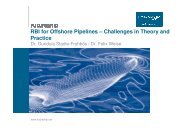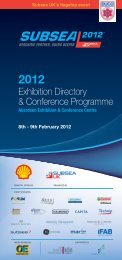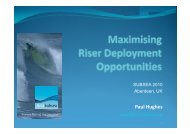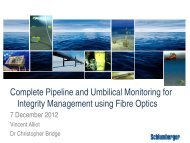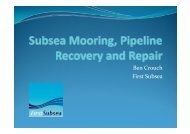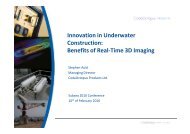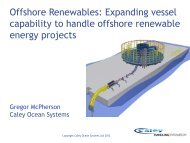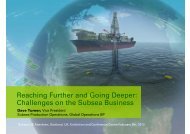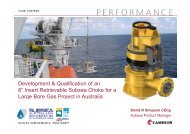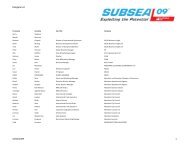Eduardo Jose - Subsea UK
Eduardo Jose - Subsea UK
Eduardo Jose - Subsea UK
You also want an ePaper? Increase the reach of your titles
YUMPU automatically turns print PDFs into web optimized ePapers that Google loves.
<strong>Subsea</strong> Scenario<br />
in Brazil<br />
Opportunities Ahead for<br />
PETROBRAS Partners<br />
<strong>UK</strong> TRADE & INVESTMENT SUBSEA OIL AND GAS<br />
INTERNATIONAL BUSINESS EXCHANGE 2012<br />
Aberdeen, <strong>UK</strong>, 6th – 10th February 2012<br />
<strong>Eduardo</strong> <strong>Jose</strong> de Jesus Coelho<br />
Technical Consultant – <strong>Subsea</strong> Control Systems<br />
PETROBRAS/E&P-ENGP/IPP/ES
1973<br />
Birth<br />
• World Oil Crisis escalate Brazil’s foreign payment debt<br />
1974<br />
• First discoveries in Campos Basin: Garoupa field,<br />
followed by Namorado and Enchova fields<br />
Challenges:<br />
• Produce the new province<br />
Key Premises:<br />
• Shortest time & Lowest cost
Strategic Decisions<br />
• O&G traditional concept: “jacket” Platform<br />
Long lead times<br />
• Campos Basin fields in 100 to 250m WD<br />
At that time such depths were “deepwater”<br />
• Solution:<br />
Early Production Systems (EPS)<br />
Develop technologies together with international suppliers and<br />
engineering companies<br />
• Benefits:<br />
Production antecipation (revenue$)<br />
Consolidates knowledge of the reservoirs while producing
Extensive use of Early Production Systems<br />
• Petrobras crafted a unique field development approach with many successful<br />
EPS before implementing the definitive systems<br />
• Some EPS even had a “phased” approach:<br />
Long Endurance Test (TLD)<br />
Pre-Pilot development phase<br />
Pilot development phase<br />
Enchova<br />
EPS<br />
Garoupa<br />
EPS<br />
Marlim<br />
EPS<br />
Roncador<br />
TLD (EPS)<br />
with EPR<br />
Jubarte<br />
TLD (EPS)<br />
EPR with ESP<br />
Pre-Salt<br />
Province:<br />
Lula (ex-Tupi)<br />
TLD (EPS)<br />
First Discovery<br />
in in Campos Basin<br />
1974 1977 1978 1992 1999 2004 2009
From EPS to “Definitive” Systems<br />
Typical example: Marlim Field Development<br />
• Pre-Pilot: March 1991<br />
• Pilot: August 1992<br />
• Main Block: 5 Modules<br />
• Production Wells: 83<br />
• Injection Wells: 46<br />
Production Units in Operation<br />
Unit<br />
Type<br />
WD<br />
Processing Capacity<br />
(m)<br />
(bpd)<br />
Start up<br />
P-20 SEMI 620 65,000 Jun-92<br />
P-18 SEMI 910 100,000 Jun-94<br />
P-19 SEMI 770 100,000 Dec-97<br />
P-26 SEMI 990 125,000 Mar-98<br />
P-32 FPSO 160 115,000 Jun-98<br />
P-33 FPSO 780 60,000 Dec-98<br />
P-35 FPSO 850 130,000 Aug-99<br />
P-37 FPSO 905 150,000 Jul-00<br />
Peak Production<br />
650,000 bopd (2002)<br />
WD: 650 - 1050 m
Campos Basin Deepwater Discoveries
Campos Basin Deepwater Discoveries
Petrobras Records & OTC Achievent Awards<br />
US GoM
Campos Basin: A Giant Technology Lab<br />
Petrobras’ Offshore Facilities<br />
Equipment<br />
<strong>Subsea</strong> Trees<br />
Installed<br />
Dec/2011<br />
793<br />
Planned<br />
(2012)<br />
32<br />
<strong>Subsea</strong> Manifolds<br />
<strong>Subsea</strong> Flexible<br />
Flowlines<br />
(km)<br />
Umbilicals<br />
(km)<br />
Rigid Pipelines<br />
(km)<br />
Floating Production<br />
Units<br />
Monobuoys<br />
25<br />
5.145<br />
3.146<br />
1.773<br />
40<br />
1<br />
5<br />
829<br />
505<br />
48<br />
2<br />
1
Lessons learned from the first Early Production Systems<br />
applied on most Petrobras field developments subsea<br />
• Single well tiebacks with wet X-Mas Trees<br />
• Flexible risers & Flowlines<br />
• Same control umbilicals for static and dynamic applications<br />
• Umbilical with thermoplastic hoses<br />
• <strong>Subsea</strong> Manifolds<br />
• Direct hydraulic control for single well tiebacks<br />
• Multiplex Electrohydraulic control for subsea manifolds and complex<br />
wet X-Mas Trees<br />
Key Strategy adopted since 1993: Standardization of <strong>Subsea</strong> Equipment<br />
Wet X-Mas Trees: Main interfaces<br />
Umbilicals: Typical configurations for DH and EHMUX controls<br />
Flexible Risers & Flowlines: ID @ WD (each Supplier)
Petrobras has a comprehensive subsea equipment<br />
Installation & Support Vessel Fleet under long term contracts<br />
Vessel types:<br />
• Rigs<br />
• PLSV for Riser, Flowline and Umbilical installation<br />
• X-MasTree deployment by cable (SESV)<br />
• DSV support<br />
• Crane barge (1000 tons)
Important Challenges (<strong>Subsea</strong>) for Mature Fields<br />
<strong>Subsea</strong> Processing<br />
<br />
Maximize the oil and gas recovery on the production concessions<br />
through subsea processing and boosting<br />
<br />
Reduce the demand for space and load on platform topside<br />
Integrity Management of the existing <strong>Subsea</strong> Equipment<br />
<br />
<br />
Ageing of a significant number of installations<br />
Extending the life of existing fields
<strong>Subsea</strong> Boosting with Electrical Submersible Pump (ESP)<br />
<strong>Subsea</strong> Completion with ESP<br />
ESP in a Dummy Well (BAB-MOBO)<br />
Seaflor ESP (S-BCSS)<br />
ESP in a Capsule above Tree Cap
<strong>Subsea</strong> Gas Separation and (liquid) Boosting<br />
with ESP in a Dummy Well<br />
• <strong>Subsea</strong> Separation System - VASPS<br />
Marimbá field - 395m WD / 2001<br />
well production increased by 1/3
<strong>Subsea</strong> Oil-Water Separation (Marlim SSAO)<br />
Platform debottlenecking, maintaining well production and water injection<br />
• 22 API<br />
• 1000 m WD<br />
• Sand handling<br />
• Demulsifier<br />
Starting operation in 2012
<strong>Subsea</strong> Multiphase Pump<br />
HELICOAXIAL MULTIPHASE PUMP FOR<br />
BARRACUDA-CARATINGA FIELD<br />
Starting operation in 2012<br />
•20 API; 80 m³/m³ GOR<br />
•1040 m WD<br />
•14 km tie-back<br />
•High boost technology
<strong>Subsea</strong> Raw water Injection System<br />
Enable water injection in the field with only minor modifications<br />
on the existing Floating Production Unit<br />
• 1000 m WD<br />
• 50 µm filter<br />
• Nitrate and bactericide injection<br />
FIRST “All-Electric” <strong>Subsea</strong><br />
Processing Equipment<br />
Three units for Albacora Field - starting operation Injectionin well 2012<br />
# 1
Petrobras New Frontier: The Pre-Salt Province<br />
Brazilian south east offshore basins in<br />
comparison with Gulf of Mexico
Pre-Salt Technological Challenges<br />
• Reservoir Quality Predictability<br />
• Well Drilling and Completion<br />
• <strong>Subsea</strong> Systems<br />
• Production System Integrity<br />
• Flexible Production Units<br />
• CO 2 Processing and Treatment<br />
• Logistics
Major Technologies & Concepts Under Evaluation<br />
Wateralternating-gas<br />
(HC or CO 2<br />
)<br />
injection<br />
Extended-reach<br />
and deviated<br />
wells (salt)<br />
Flow Assurance<br />
Dry completion<br />
systems (SPAR,<br />
TLP, FPDSO, …)<br />
Floating LNG<br />
Offshore<br />
logistical hub<br />
Pre-Salt<br />
Definitive<br />
Development<br />
CO 2<br />
separation /<br />
capture<br />
technology<br />
Reservoir<br />
Characterization<br />
Offshore gas<br />
storage in salt<br />
caves<br />
CO 2 storage in<br />
saline aquifers,<br />
depleted fields, salt<br />
caves<br />
<strong>Subsea</strong><br />
pipelines and<br />
risers<br />
Deepwater<br />
CALM buoy
Petrobras E&P Investments in Brazil
Production Forecast 2015-2020
Petrobras New Fields & Large Developments
Petrobras Increased Oil Recovery (IOR) Initaives
Petrobras Demands for 2020
Petrobras* Technological & Engineering Drives<br />
* Government Strategy
Brazilian Content Definition (by Law)
Some Opportunities in Brazil (<strong>Subsea</strong> Equipments)
Strategy for Inovation<br />
New generation of technologies developed in Brazil through key partnerships<br />
R&D Investments : US$ 5 billion (2010 to 2014)<br />
Suppliers & Service<br />
Companies<br />
R&D institutions and<br />
universities<br />
Oil Operators<br />
R&D institutions<br />
and universities
Petrobras R&D Center (CENPES) New Expansion<br />
Rio de Janeiro - Brazil
Outstanding Example of Cooperation Between <strong>UK</strong><br />
and Brazilian Companies<br />
Shared Actuator Manifold<br />
<strong>Subsea</strong> Manifold with “manual” valves actuated<br />
by a shared robotic control system
Outstanding Example of Cooperation Between <strong>UK</strong><br />
and Brazilian Companies<br />
Shared Actuator System: Petrobras Concept developed by <strong>Subsea</strong><br />
Offshore (<strong>UK</strong>) with Consub (Brazil, now <strong>Subsea</strong> 7)<br />
Torque<br />
Tool<br />
Shared Actuator Skid<br />
Robotic Tool<br />
“Walk Actuator”<br />
Ten years of operation without<br />
production loss failure
Concluding Remarks<br />
Petrobras will continue to embrace innovation:<br />
Robust investment plan in E&P will put a strong demand<br />
for subsea equipment suppliers<br />
New technology partners worldwide are welcome to<br />
invest in Brazil directly or through partnerships with local<br />
companies<br />
Several opportunities for cooperation with key partners
For more information contact:<br />
Petróleo Brasileiro S.A – PETROBRAS<br />
Investor Relations Department<br />
www.petrobras.com.br/ri<br />
petroinvest@petrobras.com.br<br />
Av. Republica do Chile, 65 – 22º floor<br />
20031-912 – Rio de Janeiro, RJ – Brazil



